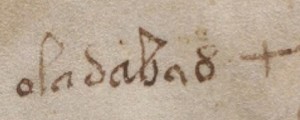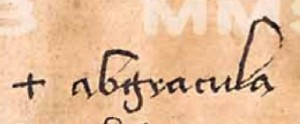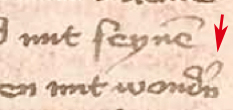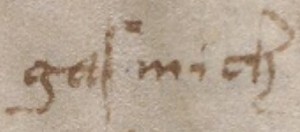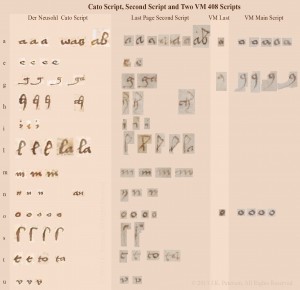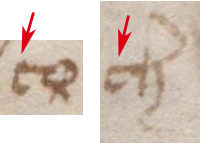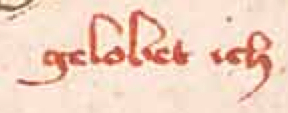Introduction
One of the most important steps in decoding a document that has defied decypherment for hundreds of years is to learn about the culture and times surrounding the creation of the manuscript.
What was important to people, how did they acquire materials, how did they become literate and who had the knowledge and means to create VM 408?
As mentioned in my post on the Voynich Zodiac Wheels, the Third Script writer (the person who wrote labels on the zodiac wheels and may have authored the cryptic text on the final page (although I prefer to refer to this as Second Script), and possibly added the substitution code columns on the righthand side of the first page) used abbreviations to label the zodiac symbols that are characteristic of those used by miniscule scribes, lines above the lowercase letters to represent missing letters.
So I asked myself, what other ways did authors have of encoding text, and searched through thousands of code systems used by royal families and others who wanted to keep information secret in the late Middle Ages and early Renaissance. This, of course, would fill books and books and has been studied at great length by cryptographers and I don’t plan to repeat it all here, but I did want to bring to light an interesting fragment that has not been mentioned yet (to my knowledge) in connection with the Voynich Manuscript.
Added Manuscript Text of Particular Interest
At the beginning and end of books, there are often blank pages, with text added by the author or someone presenting the book (e.g., a gift inscription). Often the text is written by hands other than the original author. Old bibles kept in families for generations often list the births, marriages, and deaths of many generations, and many old manuscripts have library catalog information or notes on the outer leaves, as well.
There is a written fragment on a badly torn front leaf of a long manuscript of more than 500 pages called Der Neusohler Cato. The Cato dates from the mid-1500s and the text on a front leaf shows, step by step, how the text on the left was shortened to eventually create the symbol on the right.
Here is the process. After you look at it, I also have some comments about the handwriting itself.
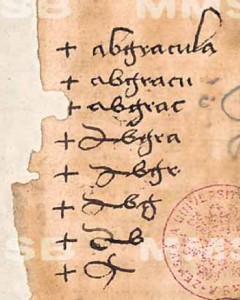 The writer started with a word,
The writer started with a word,
shortened it by leaving off the last two letters,
shortened it again by dropping another letter,
rewrote the “a” as a Greek alpha shape and dropped another letter,
dropped another letter and is progressively curving the “b”,
and another, and, finally…
found a way to express the idea as a symbol that was relatively easy to write. In a document, this might look to the reader like an X with a beginning loop (or something of that nature) when in fact, it represents an entire word.
Could this fragment have any relevance to the Voynich Manuscript? Let’s look at the script on the VM final page. The last-page script has many commonalities with the labels next to the zodiac symbols and also with the writing that comprises the majority of the Der Neusohler Cato.
Note the crosses in front of each step of the Der Neusohler Cato and the crosses between each of the letter groupings in the VM. Notice also the angularity of the loops on the letters “b” and “l” in the Der Neusohler Cato, even though the writer uses curves on many of the other letters and smooths the curves on the “b” as the word is progressively broken down into a symbol.
As a point of interest, the coded VM script is overall a bit rounder and smoother than last page Second Script. This may be relevant, or it may be a coincidence.
If we make a distinction between the formal calligraphy in manuscripts and the looser calligraphy of regular handwriting, this angular loop for the “b” and “l” is not particularly common at the time and, of special interest, can also be seen (even more angular) on the Voynich final page. Was the text on the last page of the Voynich written by the same person who coded the word on the enigmatic torn page in Der Neusohler Cato? Or someone who learned to write in the same town or household or from the same teacher? Is there enough information to determine if the two sets of text are regionally similar or the same scribe?
The handwriting on the last page of the VM is not an exact match, but bears many similarities to text at the beginning of Der Neusohler Cato. It is of particular significance because the fragment from the Cato shows to compress a word into a symbol—a form of encipherment.
We don’t know when the text was added to the Der Neusohler Cato. The manuscript is from the 1450s, and the interior handwriting resembles it, but the added text might be years later or, since it is a separate, torn page, was perhaps written earlier.
Der Neusohler Cato is from a Slavic region that was once ruled by a Hungarian king where there was a German-speaking population in the late Middle Ages. The Cato is an anthology of German medieval literature and travelogues written in different hands and assembled in one volume. One might assume it was transcribed by one of the German inhabitants, but it’s also possible it’s a translation into German by someone else.
The Cato Writer and the Voynich Manuscript
The first time I saw the last page of the Voynich Manuscript, I thought that the ![]() shape might be a letter “d” because it is commonly written in this way in a number of languages, but I think we have to stay open to the fact that it could be a coded letter or that it might be another letter written in a quirky style. Some of the calligraphic “s” shapes in Der Neusohler Cato look almost like this figure-eight “d” and might be interpreted as a figure-eight shape by viewers who don’t notice the pen direction or the slight nick in the joint.
shape might be a letter “d” because it is commonly written in this way in a number of languages, but I think we have to stay open to the fact that it could be a coded letter or that it might be another letter written in a quirky style. Some of the calligraphic “s” shapes in Der Neusohler Cato look almost like this figure-eight “d” and might be interpreted as a figure-eight shape by viewers who don’t notice the pen direction or the slight nick in the joint.
![]()
 In the same hand, in the Cato, a “v” at the beginning of the line often looks like a lower-case “b” and we know only that it is a “v” because it is followed by “on” to make “von” (German for “from”). In turn, a “u” is written like a contemporary “v”.
In the same hand, in the Cato, a “v” at the beginning of the line often looks like a lower-case “b” and we know only that it is a “v” because it is followed by “on” to make “von” (German for “from”). In turn, a “u” is written like a contemporary “v”.
It’s also important to consider how language has changed and how spelling can be influenced by its surroundings. In contemporary German, king is spelled König. In the Cato saga, king (as part of kunigreuth) is written with a “u” rather than ö. Also, when the writer switches from red ink to black, he begins to use curved “dashes” over some of the letters for abbreviations. Note the similarity of the shape of the one bottom right to the VM marks above the letters. It may be a coincidence, but it’s an observation worth tucking into a drawer for further observation.
There is a general similarity in writing style between the final page VM, the text fragment near the beginning of the Cato, and the main body text. It’s not an exact match, the Cato writer tends to connect the letters more, but it is eerily similar, including many of the letter shapes, the slant, the proportion of the upper- to lowercase letters, the crosses, and the distance between letters and words. Could it be the same person in a different point in time or a blood relation with similar handwriting? It has regional similarities to Slavic writers and might help us narrow down the origin of the Second Script writer. Here are more examples of the general similarities.
The final-page VM script and the Cato script differ in a few ways. For example, the VM writer consistently uses a square top on the letter “s” that is written like a lowercase “f” in old scripts, and the Cato writer almost always curves the top so it faces down. Also, the Cato author has a very distinctive way of writing “d” with a long flattened loop to the left, a shape that is not found on the VM final page and is not common to many scripts of the time.
The following chart gives a taste of how Cato script and Last Page Second Script have many commonalities, but are not identical and probably not by the same hand. The similarity is sufficient, however, to ask whether the scribes learned writing from the same teacher.
Handwriting Comparison
On the left of the following chart are sample letters from the main text of the Cato. The second column is taken from the majority of the text on the VM final page. The third column is from the tiny fragment of VM coded script on the final page, and the last column is VM script from the main body of VM 408.
Keep in mind that the VM “letters” probably aren’t letters at all (or it would likely have been decoded by now). They are shapes representing… something. Thus the “g” in the rightmost column may not be a “g” shape in the sense of being a letter shape, it may simply be a shape arrived at by breaking down “something” (perhaps a two-letter pair) into a representative symbol, just as the example word above was compressed to a rounded “X” shape with a starting loop. Or, it could be a number. I think there’s a strong possibility the VM “g” shape is modeled after the number 9, not the letter “g” but I included it in the chart anyway.
As far as ciphers are concerned, it’s not uncommon, in the 15th century, for a shape to represent more than one letter and for a letter to be represented by more than one shape.
Making Sense of the Final Page Second Script
The Second Script on the final page appears to be in a western European style but doesn’t match any recognizable language. Some of the letter-shapes can be recognized, and others are not so easy to decipher. In the Cato manuscript, there are more than 500 pages of readable German to help a paleographer discern which shapes were used to represent which letters (e.g., a “v” shape represents “u”) but there isn’t much context on the VM final page.
For example, it’s difficult to tell if this Second Script letter (below left and center) is a “t” or a “c”. To modern viewers, it looks like a “c”, but the letter “t” was frequently drawn this way in old manuscripts. Note the longer, straighter bar across the top on the left one. It appears to have been drawn in two strokes. The one in the middle, however, is more ambiguous. Even though the crossbar is fairly straight, the letter looks like it may have been rendered in a continuous stroke, in which case it’s probably a “c” as in the German word “ich” from the Cato manuscript on the right.
Thus, the last letters on the final page tease us by saying “val??n ubren so min gas mich” which one is eager to read as German, it’s so close, and yet it is maddeningly incomprehensible. It effectively conveys the entire Voynich experience. It’s almost, kind of, just about, nearly…
…but not quite, decipherable.
It is, however, an important step to find a style of handwriting in 15th century literature that so closely resembles last page Second Script. It may open a door illuminating a significant moment in VM history.
[See the More on Second Script Style blog for the continuation on this style of writing.]
J.K. Petersen



